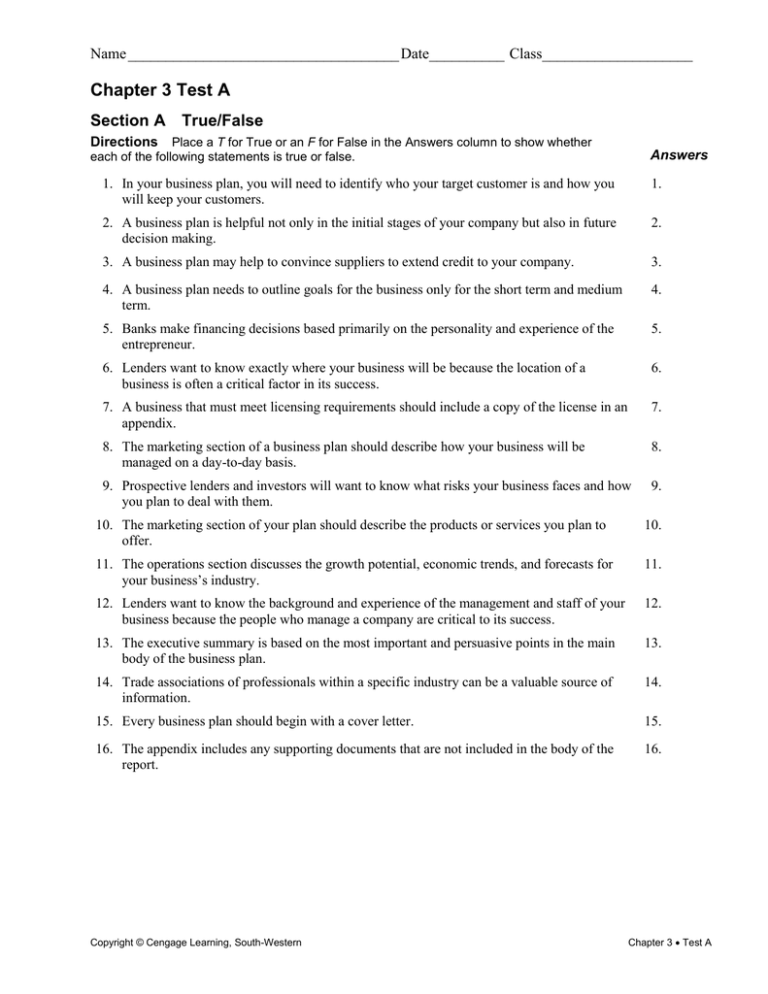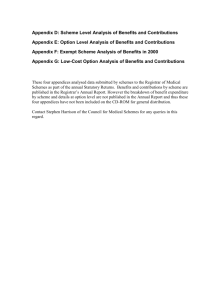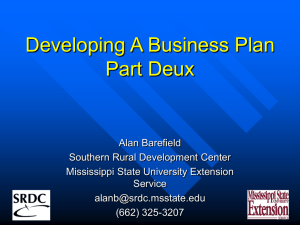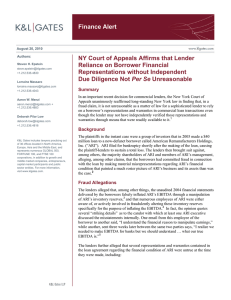Entrepreneurship Retest, Chapter 3
advertisement

Name ____________________________________ Date__________ Class____________________ Chapter 3 Test A Section A True/False Directions Place a T for True or an F for False in the Answers column to show whether each of the following statements is true or false. Answers 1. In your business plan, you will need to identify who your target customer is and how you will keep your customers. 1. 2. A business plan is helpful not only in the initial stages of your company but also in future decision making. 2. 3. A business plan may help to convince suppliers to extend credit to your company. 3. 4. A business plan needs to outline goals for the business only for the short term and medium term. 4. 5. Banks make financing decisions based primarily on the personality and experience of the entrepreneur. 5. 6. Lenders want to know exactly where your business will be because the location of a business is often a critical factor in its success. 6. 7. A business that must meet licensing requirements should include a copy of the license in an appendix. 7. 8. The marketing section of a business plan should describe how your business will be managed on a day-to-day basis. 8. 9. Prospective lenders and investors will want to know what risks your business faces and how you plan to deal with them. 9. 10. The marketing section of your plan should describe the products or services you plan to offer. 10. 11. The operations section discusses the growth potential, economic trends, and forecasts for your business’s industry. 11. 12. Lenders want to know the background and experience of the management and staff of your business because the people who manage a company are critical to its success. 12. 13. The executive summary is based on the most important and persuasive points in the main body of the business plan. 13. 14. Trade associations of professionals within a specific industry can be a valuable source of information. 14. 15. Every business plan should begin with a cover letter. 15. 16. The appendix includes any supporting documents that are not included in the body of the report. 16. Copyright © Cengage Learning, South-Western Chapter 3 Test A Section B Multiple Choice Directions In the Answers column, write the letter that represents the word, or group of words, that correctly completes the statement. 17. Short-term goals for a business might include which of the following? (a) Hire five employees, (b) Lease a facility, (c) Purchase equipment and supplies, (d) All of these. 18. The marketing section of your plan should do all of the following except (a) explain who your prospective customers are, (b) describe the market for your product, (c) explain any unique features of your product, (d) show the expertise of your sales force. 19. Identification of risks and your plan to deal with them should be in your business plan’s (a) marketing section, (b) operations section, (c) financial section, (d) appendix. 20. A business with licensing requirements would include a copy of the license in the (a) appendix, (b) executive summary, (c) marketing section, (d) no part of the business plan. 21. The cover letter of a business plan should (a) explain what you plan to do with the loan money if you receive it, (b) briefly describe your business and its potential for success, (c) be used to write the executive summary, (d) list the material included in the main body of the plan. 22. The executive summary (a) is the second introductory element, (b) should capture the interest of the readers, (c) includes the name, address, and phone number of your company, (d) is rarely read by lenders or investors. 23. The appendix includes supporting documents such as (a) current financial statements, (b) newspaper articles, (c) letters of recommendation, (d) loan requirements. 24. A business plan should (a) identify target customers, (b) show how your business will earn a profit, (c) detail who will run your business, (d) all of the above. 25. The retired executives at SCORE (a) provide advice for a small fee, (b) hold inexpensive workshops, (c) represent all areas of business, (d) have offices at the SBA. Chapter 3 Test A Answers 17. 18. 19. 20. 21. 22. 23. 24. 25. Copyright © Cengage Learning, South-Western






